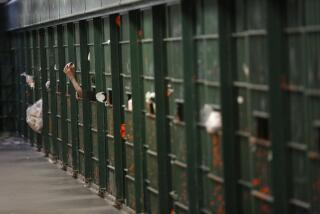Court Approval Needed to Use ‘Supermax’ Cells
- Share via
SACRAMENTO — A federal judge signed an order Thursday barring California prison officials from housing mentally ill inmates in controversial new “Supermax” isolation cells without prior approval from the court.
The order comes after lawyers for mentally ill convicts claimed the cells’ stark design creates extreme sensory deprivation that is inhumane and would make the inmates sicker.
Signed by U.S. District Judge Lawrence K. Karlton, the order represents an agreement between the attorneys and the Department of Corrections and spells out strict conditions under which the inmates may be placed in the cells.
“We’re very happy,” said Michael Bien, one of several attorneys representing convicts in the case. “If any mentally ill prisoners are placed in these Supermax units, it will be closely monitored by the court, not as part of some inappropriate experiment.”
A spokeswoman for the Department of Corrections, Margot Bach, said the state already had agreed to most of the conditions listed in the court order.
She added that all plans to place mentally ill prisoners in the special cells remain on hold pending further discussions with the attorneys, but said the department stands behind the cells’ design.
“We want the best for our inmates, and we think these units are an improvement over the current environment they’re in,” Bach said.
The dispute over the new high-security cells is part of ongoing litigation over how California’s sprawling prison system treats its mentally ill inmates.
Bach said roughly 20% of the 158,000 convicts in the state’s 33 prisons have been diagnosed as mentally disturbed.
In 1995, a federal judge found that the system provided inadequate mental health care and ordered a series of remedies. Since then, the prisons have been under the scrutiny of a court-appointed special master who monitors progress.
This week, the Department of Corrections planned to begin housing up to 52 mentally ill inmates in a new isolation unit at the Substance Abuse Treatment Facility in Corcoran. It is one of 10 such facilities--known as “administrative segregation” units--opening throughout the prison system.
Built at a cost of $86 million, the new units were built to temporarily isolate inmates who are either troublemakers or a danger to themselves.
Mentally ill prisoners are frequently housed in such facilities because they assault or are preyed upon by other inmates.
Last week, department officials informed Special Master J. Michael Keating Jr. of their plan to begin placing some mentally ill inmates in the new Corcoran unit.
Documents show the department planned to have a six-month “evaluation project” involving about 50 inmates in the new cells, and a “control group” of 50 more in traditional segregation cells.
The evaluation project is necessary, the documents say, to determine whether the new cells “result in extreme sensory deprivation that may be detrimental to the mental health of the inmates.”
Lawyers for the inmates characterized that project as an illegal experiment that put the health of their clients at risk. In a letter to the department, Keating agreed, raising concerns about placing mentally disordered prisoners in an environment of “physical austerity” and “reduced sensory input.”
“The opening in the cell door faces a blank white wall ... there is no direct natural light, and day is barely discernible from night,” Keating wrote. “Opportunities to observe the activities of other people are minimal.”
Because the mentally ill are less able to cope with social isolation, confinement in a small space and reduced stimuli, they would face extra risks in the newly designed cells, Keating said.
Bien, who toured the cells in August, said they resemble housing units at Pelican Bay State Prison that were previously declared unsuitable for mentally ill inmates by two federal judges. The judges, ruling in the lawsuit over mentally ill inmates and a separate case, found that housing psychologically disturbed convicts under such conditions violates the 8th Amendment’s bar on cruel and unusual punishment.
Bach, however, denied that the new cells are inhumane and rejected the assertion that the department planned an experiment to determine their effect on mentally ill prisoners.
She acknowledged that the cells have no windows to the outdoors--because of cost constraints--but said they provide a “quieter environment with more privacy” than the prison’s traditional isolation units.
“Right now, they’re in a fishbowl, and their meetings with psychologists take place right out in the middle of the dayroom,” Bach said. “During their exercise--a minimum of 10 hours a week--they can see the sky and talk to each other over the fence.”
Under the court order, prison officials must provide 60 days’ notice when they intend to shift a mentally ill inmate into a new cell.
In addition, they must provide to Keating and inmate attorneys proof of sufficient clinical staffing in the isolation unit; of enhanced monitoring; of screening to determine whether placement in the cells is clinically appropriate; and a process for tracking inmates to measure any negative effects.
More to Read
Sign up for Essential California
The most important California stories and recommendations in your inbox every morning.
You may occasionally receive promotional content from the Los Angeles Times.










